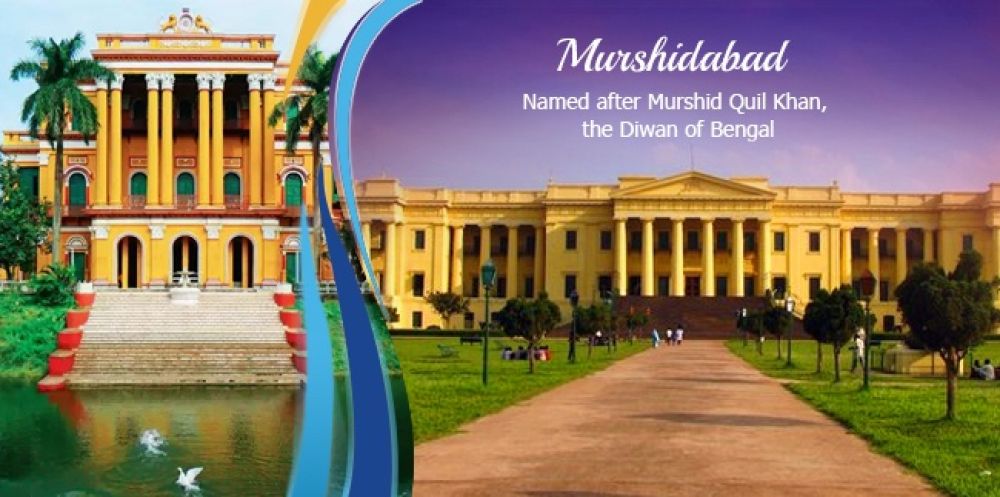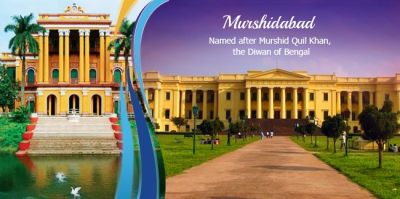

The Hazarduari Palace, or the Palace with a Thousand Doors, is the foremost attraction in Murshidabad. It is a stunning neoclassical palace constructed in the 19th century during the reign of Nawab Nazim Humayun Jah. This grandiose building now houses an extensive museum that showcases beautiful paintings, exquisite pieces of furniture, stunning chandeliers, and various artifacts that belonged to the Nawabs of Bengal. Visitors can indulge in the rich history and view the splendid Durbar Hall in the museum. The palace is a testament to the opulent lifestyle of the Nawabs and their patronage of the arts and culture. Exploring the palace and its museum can take a few hours, as there's much to absorb in terms of art, history, and architecture.
The Katra Masjid is one of Murshidabad's most famous landmarks. It was built by Nawab Murshid Quli Khan in the early 18th century and is an excellent example of Islamic architecture. Although parts of the mosque were destroyed by an earthquake, the remaining structure and the two imposing towers are still impressive. It is an important pilgrimage site and also attracts many history enthusiasts. Visitors can partake in a historical journey by exploring the mosque's architecture, which features numerous domes and two tall minarets. The peaceful atmosphere of the mosque grounds is also an ideal place for quiet contemplation and photography. The grandeur of the mosque effectively captures the essence of the cultural heritage of Murshidabad.
The Nizamat Imambara, positioned opposite to the Hazarduari Palace, is a Shi'a Muslim congregation hall. Rebuilt in 1847 by Nawab Nazim Mansoor Ali Khan after an earlier wooden imambara was destroyed by fire, it claims the title of the largest imambara in Bengal. The stunning white imambara, which visitors can explore, is known for its intricate Islamic architecture, beautiful wooden carvings, and the grandeur of its interiors. It is an active place of worship, especially during religious events like Muharram. Visitors are taken aback by its sheer size and the spiritual ambience that prevails over the structure. Those interested in religious history and architectural marvels will find a visit very rewarding.
Experience the serene beauty of Murshidabad from the water with a relaxing boat ride on the Bhagirathi River. A boat trip allows visitors to enjoy local life along the riverbanks, observe the farming activities, catch glimpses of historical sites from a different vantage point, and witness stunning sunsets. The slow-paced boat ride can be a tranquil retreat from the hustle and bustle of everyday life. Visitors have the chance to engage with boatmen, who often share interesting historical tales and folklore associated with the river and its surroundings. This boat ride is not only a calming activity but also offers a cultural insight into the life of the people living along the Bhagirathi.
Motijheel, meaning 'Pearl Lake', is a beautiful, horseshoe-shaped lake in Murshidabad. It was once the garden of Nawab Siraj-ud-Daulah and later the British turned it into a cemetery. The site offers a charming glimpse into the historic past of the town. Visitors can stroll around the lake and enjoy the tranquility of the area, visit the graves of British officers, or simply relax in the serene environment. The landscape around Motijheel is picturesque, making it an excellent subject for photography enthusiasts. The stroll is likely to evoke a strong sense of history and provides a perfect blend of natural beauty and historical significance.
The Fauti Masjid of Murshidabad is a grand mosque with an impressive facade and five domes. Constructed by Nawab Sarfaraz Khan in 1740, it is an architectural masterpiece with a charming interior and a large courtyard. Visitors are normally impressed by its sheer size and the architectural finesse. The mosque also has an interesting history related to Nawab Sarfaraz Khan’s ascension to the throne. Although not as frequented by tourists as the other major attractions, it provides a peaceful environment to learn about the local Islamic culture and appreciate the intricate architecture of the mosque. The beauty of the mosque lies in its simplicity and historical importance.
Murshidabad is known for its rich tradition of handicrafts, especially silk weaving. Visitors to the local markets can experience the vibrant bazaars filled with colourful textiles, brassware, and local handicrafts. Shoppers can buy exquisite Murshidabad silk saris, famous for their texture and craftsmanship. The bustling markets provide a glimpse into the local way of life and are great places to witness the skills of local artisans and to purchase some unique souvenirs. While roaming through the markets, visitors will find shops and stalls selling a variety of local sweets and snacks that are worth tasting. Visiting these markets is not only about shopping; it's an immersive cultural experience that reflects the customs and traditions of Murshidabad.
The Jafarganj Cemetery is a historical site where members of the Nawab family of Murshidabad, their relatives, and other high-ranking officials were buried. The cemetery is located near the Hazarduari Palace and contains around a thousand graves, including that of Nawab Siraj-ud-Daulah. The place has a somber yet intriguing atmosphere, brimming with stories of the Nawabs and their once-thriving dynasty. The ancient tombs and the peace that surrounds this cemetery make it a site of historical significance. History buffs will appreciate the narratives that echo through the silence of the grounds, and visitors can reflect upon the lives of the individuals who played significant roles in Bengal's history.
Footi Mosque is an incomplete mosque structure in Murshidabad, and it represents an architectural enigma. The folklore suggests it remained incomplete because work stopped immediately after the death of Nawab Siraj-ud-Daulah in the Battle of Plassey. It stands as a silent witness to the region's rich past and the power struggle that shaped Bengal's history. Exploring this partially built mosque gives one a sense of the artistic vision that might have been, yet its incompleteness adds to its charm and mystique. Wandering through the ruins allows visitors to contemplate history and the occurrences that prevented its completion. For those interested in unfinished historical structures and the tales behind them, a visit to Footi Mosque is a must.
Khosh Bagh is a peaceful garden that houses the graves of Nawab Alivardi Khan and Siraj-ud-Daulah along with other members of the Nawab family. Located on the banks of the Bhagirathi River, it offers a tranquil environment and is known for its well-maintained gardens. Visitors can walk among the beautifully landscaped grounds, admire the marble tombstones, and experience the aura of peace and respect that pervades the area. It is a place where history and harmony coexist. Photography is often permitted, and the scenic backdrop of the river makes for great pictures. It's an ideal spot for a quiet stroll and reflection, diving into the depths of Bengal's historic timeline while enjoying the natural setting.
